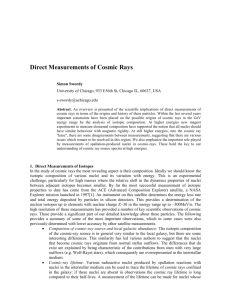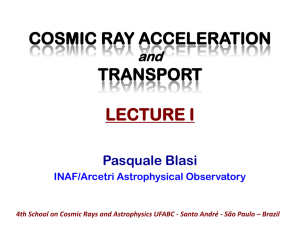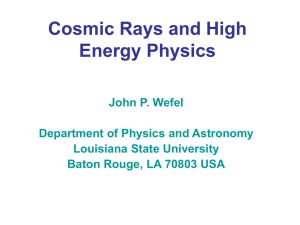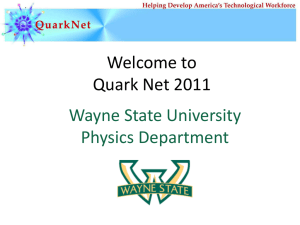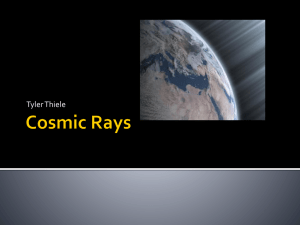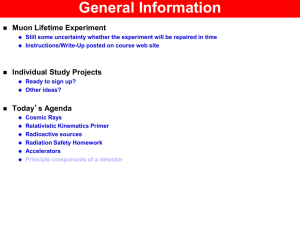COSMIC RAYS
advertisement
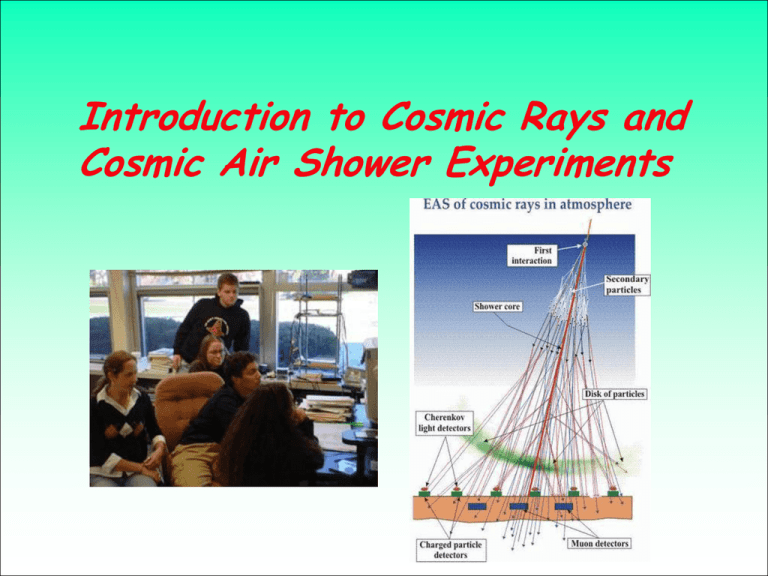
Introduction to Cosmic Rays and Cosmic Air Shower Experiments • Cosmic Rays in a Nutshell: • High energy particles traveling throughout our galaxy at close to the speed of light. • Consist of elementary particles such as electrons (and positrons) and nuclei of atoms, mostly single protons (a few are much heavier). Cosmic Rays continually bombard the Earth. In fact, about 100,000 cosmic rays will pass through a person every hour! Cosmic rays-a long story • • • C.T.R Wilson discovered in 1900 the continuous atmospheric ionization. It was believed to be due to the natural radiation of the Earth. In other words, from the ground up. Wilson noticed the reappearance of drops of condensation in expanded dust free gas, the first cloud chamber. Wilson suspected the tracks might be condensation on nuclei - ions that were the cause of the “residue” conductivity of the atmosphere. Where did the ions come from? • At the beginning of the 20th century scientists were puzzled by the fact that more radiation existed in the environment than could be explained by natural background radiation • The debate was solved on a balloon flight in 1912 from the University of Vienna. Victor Hess • In 1912 a Victor Hess, a German scientist, took a radiation counter (a simple gold leaf electroscope) on a balloon flight. • He rose to 17, 500 feet (without oxygen) and measured the amount of radiation increase as the balloon climbed. • Victor discovered that up to about 700 m the ionization rate decreased but then increased with altitude showing an outer space origin for ionization. Not from the Sun • During subsequent flights Hess determined that the ionizing radiation was not of solar origin since it was similar for day and night. • It was initially believed that the radiation consisted of gamma rays only. • But there was still a dispute as to whether the radiation was coming from above or from below. Birth Cries of the Atoms • In 1925 Robert Millikan of Caltech introduced the term “cosmic rays” after concluding that the particles came from above not below a cloud chamber. • He used elaborate electroscopes. Cosmic Rays are Charged Particles! • In 1929 a Russian scientists, D. Skobelzyn, discovered ghostly tracks made by cosmic rays in a cloud chamber. • Also in 1929 Bothe and Kolhorster verified that the cloud chamber tracks were curved by the magnetic field. Thus the cosmic radiation was charged particles. Carl Anderson discovers antimatter • Milliken became President of Caltech and was instrumental in the building of a high magnetic field cloud chamber. • Carl Anderson and Milliken made numerous photographs of both positive and negative particles tracks. • 1933 While watching the tracks of cosmic rays passing through his cloud chamber, Carl Anderson discovered antimatter in the form of the anti-electron, later called the positron. “Who ordered that?” I. Rabi 1937 • Seth Neddermeyer and Carl Anderson discovered the elementary subatomic particle called the muon in cosmic rays. • The positron and the muon were the first of series of subatomic particles discovered using cosmic rays—discovered using cosmic rays, discoveries that gave birth to the science of elementary particles physics. • Particle physicists used cosmic rays for their research until the advent of particle accelerators in the 1950's. Carl Anderson at LBNL 1937 Extensive air showers 1938 • • Pierre Auger, who had positioned particle detectors high in the Alps, noticed that two detectors located many meters apart both signaled the arrival of particles at exactly the same time. Auger had discovered "extensive air showers," showers of secondary subatomic particles caused by the collision of primary high-energy particles with air molecules. On the basis of his measurements, Auger concluded that he had observed showers with energies of 1015 eV—ten million times higher than any known before. •Movie An Extensive Air Shower • Cosmic rays enter the earth’s upper atmosphere and interact with nuclei. • Secondary particles result that also interact. • The shower grows with time. • Certain particles never reach the surface. • Some particles, such as muons, do reach the surface and can be detected. • It is these that we wish to detect. composition of primaries • 90% protons (not anti-protons) • The remainder mostly follow solar system abundances (eg meteorites and solar photosphere) – Spallation of O and C nuclei, for example, create more Li, Be, B than is typical of solar system cosmic rays solar system Cosmic rays at earth’s surface (secondaries) • Primaries interact at z15 km, producing a shower of (mostly) short-lived particles. – e.g. pion () lifetime is 2.610-8 s • The long-lived secondaries are: – e, photons: mostly absorbed – neutrinos (): practically invisible – muons (): =lifetime is 2.210-6 s • Without time dilation, muons would travel dc=660 m, with a survival fraction e-0.66/15 10-10 • Instead, for a 10 GeV muon, =10/0,1=100, then mean distance is 66 km. (OK) • Detectable (vertical) flux is 1/cm2/min • Simulated event: start...end • Movie • Sim tool Present Cosmic Ray Studies • Cosmic Ray studies continue in spite of the development of high energy particle accelerators. • The energy of the highest energy cosmic rays still cannot be duplicated in accelerators. • The field is still very active as indicated by the presentation of over 300 papers at the most recent international conference on cosmic rays. What’s been learned from the research What are cosmic rays? • Primaries are particles with energies from 109 eV to 1021 eV. • An eV is a unit of energy. A 40 W reading light uses about 1034 eV of energy in one hour. (from James Pinfoli, Pinfold@phys.ualberta.ca) Cosmic rays within the range of 1012 eV to 1015 eV have been determined to be: 50% protons 25% alpha particles 13% C, N, and O nuclei <1% electrons <0.1% gammas The Energy Spectrum • Existing models for the production of cosmic rays only work to 1015 eV. • CR in excess of 1019 eV are believed to come from sources relatively close to our Galaxy, but the sources are unknown. – The highest energies! – (www.phys.washington.edu) The Oh My God Particle • In 1991 at the Fly’s Eye CR observatory in Utah a primary particle of 3 x 1020 eV was recorded. This is the equivalent of 51 joules • At present particle accelerators can reach energies of 1012 eV. • The Fly Eye • (from www.physics.adelaide.edu) The AGASMA EVENT In Japan, in 1993, the worlds largest array recorded a large air shower believed to be the result of a primary particle measured at 1021 eV. These particles have energies six times higher than present theories allow. The mystery is, of course, what is the source of the high energy particles including these ultrahigh energy particles. Where do they come from? • Low energy rays (less than 10 GeV) come from the sun. • Supernovae may be the source of particles up to 1015 eV. • The sources for ultrahigh cosmic rays are probably, active galactic nuclei and gamma ray bursts. (www.phys.washington.edu) Supernovas 1949 • Enrico Fermi put forth an explanation for the acceleration of cosmic rays. In Fermi's cosmic ray "shock" accelerator, protons speed up by bouncing off moving magnetic clouds in space. Exploding stars (supernovae) are believed to act as such cosmic accelerators, but they alone cannot account for the highest energy cosmic rays. • Nuclei receive energy from the shock wave of the supernova explosion. • The energy spectrum indicates that most of the supernova particles have less than 1015 eV • (image from: www.drjoshuadavidstone.com/ astro/supernova.jpg SN1006 = Crab Nebula • The Crab Nebula in visible light… …and in cosmic rays (radiation from electrons in the supernova remnant), showing the shell of the supernova remnant still expanding into space How do we know SNs make galactic cosmic rays? • One clue: the abundances of different nuclei in galactic cosmic rays (GCR) is almost the same as the abundances in a mature star like the Sun • Differences between solar and GCR abundances in the graph above are almost perfectly explained by nuclei fragmenting as they travel through interstellar space and strike occasional bits of matter • The average GCR spends several million years wandering around our Galaxy before reaching Earth (we deduce this from abundances of radioactive elements) The ultra high particles? • Without going into great detail the problem with the source of the UHECR is that to achieve the high energies they must originate in a very large extragalactic field or from a process that doesn’t require such distance. • Suggestions abound but there is not a agreement as to the origin. Maybe there isn’t a single source. • One suggestions is that UHE CR’s originate from the decay of more primary particles resulting from the big bang. What’s been learned from the research Summary -Energy Density of CR • Lower energy, < 1016 eV: – Direct observation possible, 85% are protons. – Most likely source are supernova shock wave acceleration. – These are particles below the knee in the energy spectrum. • Ultra High energy, > 1016 eV. – Only indirect EAR shower information is available. – Source of the particles with > 1016 eV is unknown. High School Based Detectors Numerous detector arrays using high schools as sites for individual detectors have been built or are in the process of development. The projects range from arrays using hundreds of detectors covering thousands of km2 to small arrays involving only a few detectors in an area only a few hundred meters square. Why put cosmic ray detectors in schools? • Important open questions about extremely high energy (UHE) cosmic rays: – Where do cosmic rays with E>1020 eV come from? – How can they be produced and accelerated? – How can they reach us through intergalactic space? • UHE-CR research requires simple detectors, spread over a large area, with accurate time synchronization • High cost for conventional physics experiment: new equipment, land use, data networks, and site support – Example: Auger Project: > US$ 108 • Solution: Physicists provide surplus HEP equipment, schools provide sites and Internet port School-network approach • Pioneered by U. of Alberta in Canada (ALTA) and U. of Nebraska in USA (CROP) • University joins secondary schools to build a very large detector array at low cost, using existing resources in the community, and surplus equipment • Use schools’ existing Internet access to link the sites • Students and teachers participate in forefront research More than a one-time field trip or term paper Doing, not watching Research is ongoing, in the school every day Students help monitor detectors and analyze data Long-term relationship between school and University CHICOS (California high school cosmic ray observatory) • Operated by Caltech, CHICOS is an active research array with a goal to study CR is the range of 1018 to 1021 eV using refurbished detectors from a neutrino experiment and 1 m2 scintillators • Currently 51 sites are setup and working. • Image from www.chicos.caltech.edu ALTA (University of Alberta Large Time Coincidence Array) • The stated purpose of the ALTA project is to search for time correlations between EAS’s. • At present 16 high schools are involved. • The project is part of the Canadian learning standards with students receiving credit. • (image from www.physics.ubs.ca) ALTA MAP ALTA DETECTOR MAP Hinton Size of planned Auger detector Fort McMurray EDMONTON CROP (Cosmic Ray Observatory Project, University of Nebraska) • A project to study EAS from particles > 1018 eV. • Thirty operating schools covering 75000 sq miles is the goal of the project. • Detectors are 1 m2 scintillators donated by the Chicago Air Shower Array. • Image from Marion High School. Http://marian.creighton.edu SALTA (Snowmass Area Largescale Time-coincidence Array) • A project to set up detectors in Colorado. • Linking high schools via Internet connecting to form a large array. • A modern hot-air balloon flight in 2001 reenacted Hess’s 1912 flight. Image from: http://faculty.washington.edu/ ~wilkes WALTA (Washington Large Area Time Array) • A project of the University of Washington. • As of late 2006 eighteen high schools around Seattle are participating. See image. (from www.phys.washington.edu ) The Pitt/UMSL Projects A project of the University of Pitt and University of Mo at St. Louis. The project involves high school teachers building and using scintillator type detectors aimed at muon detection. The QuarkNet Detector Cosmic Ray E-lab Example Student Poster Example Student Plot
